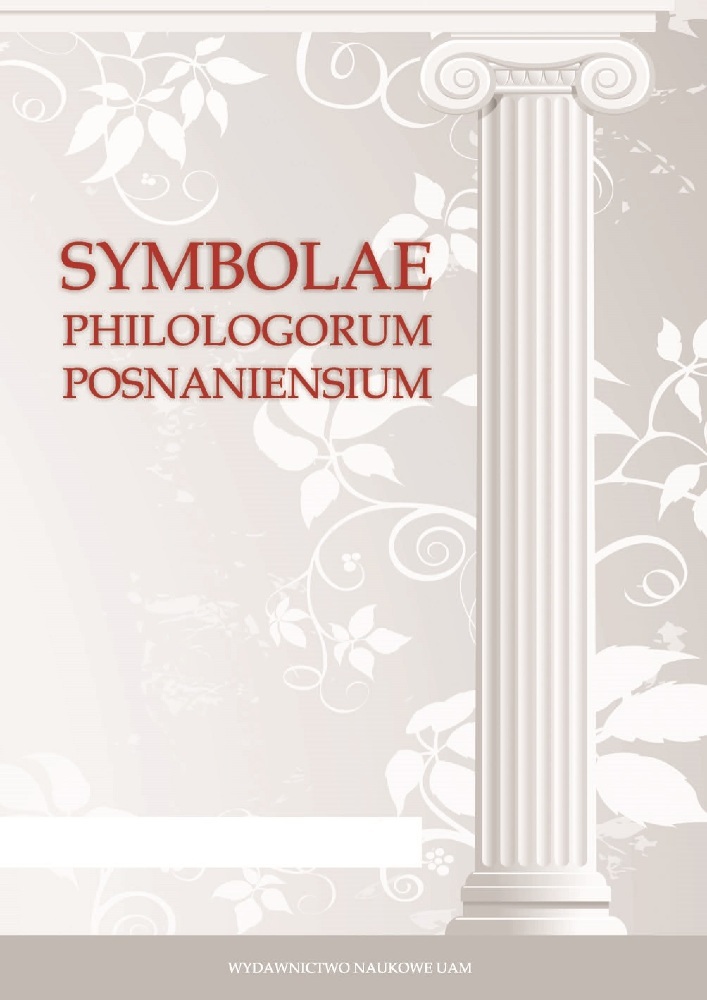Abstract
The paper examines the representation of Seneca in two literary works of the late 1st and early 2nd centuries AD, the anonymous tragedy Octavia and the Annals by Tacitus. In the Octavia Seneca appears as the emperor Nero’s upright but unhappy teacher trying in vain to inculcate salutary advice to his master. There is no question of his being responsible for the crimes of Nero; the picture of him drawn in the play is wholly favourable. The portrayal of Seneca in Tacitus’ Annals is more complex and nuanced, and only seldom does the historian give his own views about Nero’s advisor. However, it would be wrong to suppose that Seneca is harshly criticised by Tacitus.
Literaturhinweise
Primary sources:
Koestermann 1968: Koestermann, E. 1968. Cornelius Tacitus, Annalen, erläutert und mit einer Einleitung versehen von, Bd. IV: Buch 14–16, Heidelberg.
Préchac 1990: Sénèque, De la clémence. Texte établit et traduit par Préchac, F. 1990. LXV–LXXI Paris. Collection des universités de France.
Secondary sources:
Abel 1991: Abel, K. 1991. Die Taciteische Seneca-Rezeption, 3155–3181. ANRW II 33, 4.
Alexander 1952: Alexander, W.H. 1952. „The Tacitean “Non Liquet” on Seneca,” University of California Publications in Classical Philology 14: 269–386 (also as a separate book).
Alexander 1954: Alexander, W.H. 1954. “The Communiqué to the Senate on Agrippina’s Death,” Classical Philology 49, 94–97.
Armisen-Marchetti 1998: Armisen-Marchetti, M. 1998. “Le Sénèque de l’Octavie: imago imaginis”. Pallas 49: 198.
Borgo 2009: Borgo, A. 2009. “Un costrutto tacitiano: incertum an,” Bollettino di studi latini:periodico semestrale d’informazione bibliografica. Napoli.
Boyle 2008: Boyle, A. J. 2008. Octavia Attributed to Seneca, Oxford.
Brinkmann 2002: Brinkmann, M. 2002. Seneca in den Annalen des Tacitus, diss. Bonn.
Bruckner 1976: Bruckner, F. 1976. Interpretationen zur Pseudo-Seneca-Tragödie Octavia, diss. Erlangen–Nürnberg.
Cogitore 1991: Cogitore, I. 1991. „La potentia chez Tacite: accusation indirecte du Principat,” Bulletin de l’Association Guillaume Budé: 158–171.
D’Anna 2003: D’Anna, G. 2003. „Seneca uomo politico nel giudizio di Tacito,” In De Vivo A., Lo Cascio, A. (a cura di), Seneca uomo politico e l’età di Claudio e di Nerone. Atti del Convegno internazionale (Capri 25–27 marzo 1999), 193–210. Bari.
Devillers 2002: Devillers O. 2002. „Le rôle des passages relatifs à Thrasea Paetus dans les „Annales” de Tacite,” In Neronia VI: Rome à l’époque néronniene; Institutions et vie politique, économie et société, vie intellectuelle, artistique et spirituelle. Actes du VIe colloque international de la SIEN (Rome, 19–23 mai 1999), Crosille, J.M. et Perrin, Y. eds. Latomus, Bruxelles, 2002. (Coll. Latomus, vol. 268): 296–311.
Dürr 1940: Dürr, K. 1940. „Seneca bei Tacitus,” Gymnasium 51: 42–61.
Dyson 1970: Dyson, S.L. 1970. „The Portrait of Seneca in Tacitus”, Arethusa 3: 71–83.
Ferri 2003: Ferri, R. 2003. Octavia: A Play Attributed to Seneca, Cambridge.
Gatz 1967: Gatz, B. 1967. Weltalter, goldene Zeit und sinnverwandte Vorstellungen, Hildesheim.
Gerber, Greef 1903: Gerber, A., Greef, A. 1903. Lexicon Taciteum, Leipzig.
Gercke 1895: Gercke, A. 1895. Seneca-Studien, Leipzig.
Giancotti 1983: Giancotti, F. 1983. Seneca personaggio dell’Octavia, “Orpheus” 4: 215–252.
Gillis 1963: Gillis, D. 1963. „The Portrait of Afranius Burrus in Tacitus’ Annales.” Parola del Passato 18: 5–22.
Griffin 1976: Griffin, M. 1976. Seneca: A Philosopher in Politics, Oxford.
Grimal 1967: Grimal, P. 1967. „Le discours de Sénèque à Neron dans les Annales de Tacite.” Giornale italiano di filologia. 20: 131–138.
Heldmann 1991: Heldmann, K. 1991. “Libertas Thraseae servitium aliorum rupit. Überlegungen zur Geschichtsaufassung im Spätwerk des Tacitus.” Gymnasium 98: 207–231.
Henry, Walker 1963: Henry, D.V., Walker, B. 1963. „Tacitus and Seneca,” Greece and Rome 10: 98–110.
Herington 1961: Herington, C.J. 1961. “‘Octavia Praetexta’: A Survey”, Classical Quarterly 11: 18–30.
Kearns 2011: Kearns, E. 2011: “The Death of Thrasea: Towards a Reconstruction and Interpretation”, Athenaeum 99.
Ker 2012: K er, J. 2012. „Seneca in Tacitus,” In Pagán, V.E. A Companion to Tacitus, Malden, 305–329.
Kienast 2004: Kienast, D. 2004. Römische Kaisertabelle. Grundzüge einer römischen Kaiserchronologie, Darmstadt 3.
Korpanty 1975: Korpanty, J. 1975. “Z dziejów rzymskiej pietas.” Meander 30: 7–18.
M. Brinkmann, M. 2002. Seneca in den Annalen des Tacitus, diss. Bonn .
Manuwald 2001: Manuwald, G. 2001. Fabulae praetextae. Spuren einer literarischen Gattung der Römer, München.
Manuwald 2002: Manuwald, G. 2002. “Der “Fürstenspiegel” in Senecas De clementia und in der Octavia.” Museum Helveticum 59: 107–126.
Manuwald 2003: Manuwald, G. 2003. „The Concepts of Tyranny in Seneca’s Thyestes and in Octavia”, In Wilson, M. (ed.), The Tragedy of Nero’s Wife. Studies on the “Octavia Praetexta”, Auckland (= “Prudentia” 35,1): 37–59.
Pigoń 2004a: Pigoń, J. 2004. “Thrasea Paetus, libertas senatoria, and Tacitus’ Narrative Methods”, In Brodka, D., Janik, J., S. Sprawski, S. (eds.), Freedom and its Limits in the Ancient World.
Proceedings of a Colloquium Held at the Jagiellonian University, Krakow, September 2003, 143–154. Kraków.
Pigoń 2004b: Pigoń, J. 2004. Ze studiów nad technikami narracyjnymi Tacyta. Wypowiedzi proleptyczne, Wrocław.
Pigoń 2009–2012: Pigoń, J. 2009–2012. “Od uwielbienia do wzgardy: Seneka w oczach Rzymian (do połowy II wieku),” Meander 64–67: 83–100.
Richter 1961: Richter, W. 1961. „Römische Zeitgeschichte und innere Emigration,” Gymnasium 68: 306.
Schmal 2008: Schmal, S. 2008. „Held oder Harlekin? Der sterbende Seneca bei Tacitus,” Klio 90: 105–123.
Schmidt 1985: Schmidt, P. L. 1985. Die Poetisierung und Mythisierung der Geschichte in der Tragödie Octavia in ANRW II,32,2, 1421–1453.
Syme 1958 : Syme, R. 1958 Tacitus, Oxford.
Trillitzsch 1971: Trillitzsch, W. 1971. Seneca im literarischen Urteil der Antike. Darstellung und Sammlung der Zeugnisse, Bd. 1: Darstellung, Amsterdam 1971.
Volkmann 1967: H. Volkmann, H. 1967. „Die Basileia als ἔνδοξος δουλεία. Ein Beitrag zur Wortgeschichte der Duleia,” Historia 16: 155–161.
Wallace-Hadrill 1983: Wallace-Hadrill, A. 1983. Suetonius: The Scholar and His Caesars, London.
Wesołowska 1995: Wesołowska, E. 1995. „Monolog czy dialog? Interakcja Atreusa i służącego w Tyestesie Seneki (v. 176–335),” In Lewandowski, I., Wójcik, A. (eds.), Vetustatis amore et studio. Księga pamiątkowa ofiarowana Profesorowi Kazimierzowi Limanowi, 101–106. Poznań.
Zimmermann, M. 1889. De Tacito Senecae philosophi imitatore, Breslau.
Lizenz
